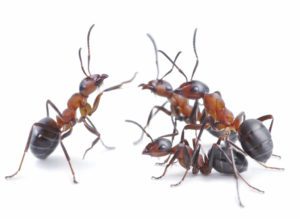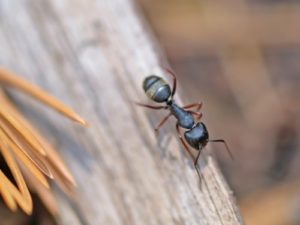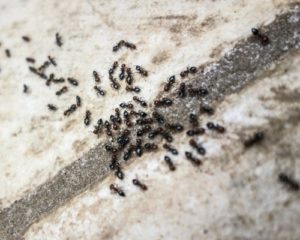Whether you’ve got small ants in the kitchen or large ants in the bathroom, you’ve got a problem.
Ants are a common nuisance for many Maryland homeowners because they can sting people, contaminate food, and damage wood. Once they’ve entered your home, they’re extremely hard to get rid of without a residential pest control expert – that’s why prevention is key!
These persistent and highly adaptable creatures can be a real headache, but don’t let them bug you (pun intended!).
Take a look at these 5 common ants in Maryland, and we’ll teach you some steps you can take to prevent them from entering your home:
Meet the 5 Most Common Types of Ants in Maryland
Here’s a quick guide to identifying and preventing some of the most common ant types in Maryland:
| Ant | Traits | Habits & Risks | Prevention Tips |
|---|---|---|---|
| Pavement Ants | Light brown to black, typically build nests in cracks in pavement. | Found in kitchens and bathrooms, attracted to food and moisture, can contaminate food sources. | Seal cracks in your foundation and around windows/doors, clean up spills quickly, store food in sealed containers. |
| Odorous House Ants | Tiny (2.4mm-3.3mm), emit a rotten coconut smell when crushed. | Found in kitchens and bathrooms, attracted to sweets and grease, can contaminate food sources. | Eliminate standing water, store firewood away from your home, seal cracks around the foundation. |
| Carpenter Ants | Black, red, or a combination, have a “pinched” waist. Can damage wood. | Found near wood, attracted to moisture and damaged wood, can damage wooden structures in your home. | Address moisture issues, store firewood far away, trim trees/bushes away from your house, seal cracks around the foundation and windows/doors. |
| Acrobat Ants | Small, easily recognized by their heart-shaped abdomen. Sting when threatened. | Found in walls and ceilings, attracted to sweets and grease, can sting when threatened. | Seal cracks and openings around windows/doors, store food properly, avoid leaving dirty dishes out. |
| Thief Ants | Tiny (1.5mm-2.2mm), yellowish to brown. Steal food from other ant colonies. | Found near food sources, attracted to sweets and grease, can contaminate food sources. | Maintain a clean kitchen, keep food in sealed containers, remove vegetation near the foundation. |
1. Acrobat Ants
You can easily recognize an acrobat ant – its unique, heart-shaped abdomen is a dead giveaway. These ants are small and tend to enter homes through cracks in the foundation and the small gaps around windows and doors.
When they enter your home, you might be unpleasantly surprised to find them in your food, contaminating it so that it is inedible. They also sting when threatened, so keep that in mind if you spot one.
Here are some steps you can take to prevent acrobat ants from invading your home:
- Use caulk to seal any openings around windows, doors, pipes, and utility entrances.
- Seal any cracks in the foundation and exterior walls of your home.
- Avoid leaving food and/or dirty dishes out in your kitchen, and store pet food properly.
2. Carpenter Ants

If you’re trying to identify carpenter ants in or around your home, ask yourself these questions:
- Do the ants have wings?
- Do the ants have a constricted waist?
- Are the ants black, red, or a combination of those colors?
- Do the ants have a one-node waist?
- Did you find the ants near or inside of wood (especially water-damaged wood)?
If you answered yes to all of these questions, there is a good chance you’ve spotted carpenter ants. You may also have carpenter ants if you hear a rustling sound inside the wooden structures of your home or if you find wood shavings on your floor mixed in with dead ants.
These ants build their nests inside of wood, tunneling and removing the wood along the way. Once they enter your home, they can contaminate both human food and pet food.
Here are a few steps you can take to keep carpenter ants out of your home:
- Because carpenter ants need moisture to survive, you can keep them away by replacing water-damaged wood in or around your home. Also, check your gutters to make sure that they are properly draining water away from your home.
- If you have firewood, be sure to store it as far from your home as possible.
- Trim any trees and/or bushes so that they do not come into contact with the walls of your home.
3. Odorous House Ants
These ants are tiny, typically measuring anywhere from 2.4mm to 3.3mm in length. They can be most easily identified by their signature scent – crush one, and you’ll notice that it emits a rotten coconut smell.
Odorous house ants are often the small ants in the kitchen area – they have a sweet tooth, so don’t leave sugary food within their reach, or it’s likely that they will contaminate it. You can also find them around your pet’s food and in your bathroom.
Here are a few more tips for preventing an odorous house ant infestation in your home:
- Get rid of any standing water.
- These ants build nests in stacks of wood, so keep any firewood stored far from your home.
- Seal any cracks or openings near the bottom of your home’s foundation.
- Make sure that plants and tree branches are cut so that they don’t touch your home.
4. Pavement Ants
You guessed it – these ants typically build their nests in or under cracks in pavement! They can also be found inside the home in walls and under floors.
You might be surprised to learn that they aren’t common throughout the entire United States – they’re only present in the eastern half, so they’re definitely a problem here in Maryland.
To identify pavement ants, look for a light brown to black ant – it will have legs that are lighter in color than the rest of its body. They’re quite harmless and don’t bite, but they can still contaminate your food and the food preparation surfaces in your home.
Here’s how you can help prevent pavement ants from entering your home:
- Clean up quickly any time you spill your food, a beverage, or your pet’s food, and keep your kitchen as clean as possible.
- Keep all of your food stored in sealed containers.re
- Seal up your foundation and any cracks around windows/doors.
5. Thief Ants
You can identify these ants by their size and color. They’re one of the tiniest household ants in the world, usually measuring from 1.5mm to 2.2mm in length, and they range in color from yellowish to brown.
And yes – they really are thieves! In fact, they’re called thief ants because they steal larvae and pupae from neighboring ant colonies. They have another nasty habit too – they sometimes feed on dead rodents, meaning they’ll contaminate your food if they come into contact with it.
Here’s how to stop thief ants from invading your home:
- First, make sure you’ve correctly identified the ants. Thief ants look similar to Pharaoh ants, and if you can’t tell them apart, you should contact your favorite residential pest control provider for help.
- Keep your kitchen and home clean. Make sure you don’t let food scraps and dirty dishes sit out for long periods of time.
- Make sure that any vegetation is kept away from your home’s foundation.
What to Do When Ants Invade
As you can see, prevention steps for most types of ants include similar tactics, like sealing up cracks in your home’s foundation and keeping your kitchen area clean.
However, even following these steps, you could still experience an ant infestation. When that happens, you may feel the urge to reach for insect spray. While that may provide a temporary solution, you’ll be disappointed to find the ants returning again before long.
If you really want to prevent ants from returning to your home, get in touch with the ant control team at Brody Brothers Pest Control.
Not only do we provide preventative pest control services – we also have over 40 years of experience helping people get ants out of their homes, and we’d love to help you next!
If ants have already invaded your home, our professionals will destroy every member of the ant colony, providing you with a permanent solution. We only use the highest quality products and proven treatments, and our solutions are safe for your home.
Ready to get rid of your ant problem for good? We offer a free inspection to assess your situation and develop a customized plan that works for you. Contact us today and experience the Brody Brothers’ difference!
Remember, you’re not alone in the fight against ants! We’re here to help you enjoy a pest-free Maryland home.

